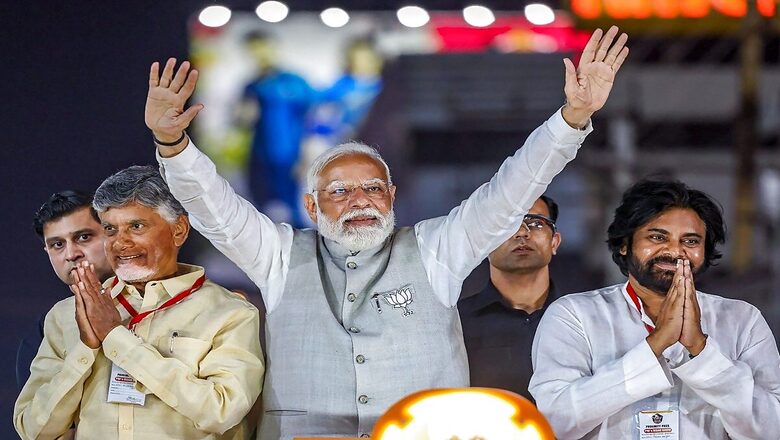
views
In the kaleidoscope of Indian politics, Andhra Pradesh has emerged as a battleground where the Bharatiya Janata Party (BJP) is steadily carving a niche for itself. As the Lok Sabha elections progress, the BJP’s ascendancy in this traditionally non-Hindi heartland state warrants closer examination. It is important to unravel the layers behind the BJP’s emerging dominance in Andhra Pradesh and what it means for the state’s political future.
The BJP’s edge in Andhra Pradesh is not a sudden phenomenon but the culmination of meticulous strategy and political foresight. The party’s alliances with regional forces like the TDP and Jana Sena have been masterstrokes, creating a formidable front that challenges the entrenched regional parties. Moreover, a high voter turnout of 67 per cent suggests a populace eager for change, potentially tilting the scales in the BJP’s favour.
Prime Minister Narendra Modi’s overarching narrative of development and governance has found resonance among the electorate, who are increasingly aligning with the BJP’s vision for a ‘New India’. The party’s promise to bring about transformative change has struck a chord with the aspirational voters of Andhra Pradesh. The Opposition, fragmented and embroiled in internal conflicts, presents a scattered picture, inadvertently playing into the hands of the BJP. The party’s strategic positioning as a harbinger of stability and progress presents a stark contrast to the Opposition’s narrative of discord and disarray.
Local issues, too, have played a pivotal role. Dissatisfaction with the current state government’s performance on various fronts has opened doors for the BJP to present itself as the alternative the state desperately seeks. The BJP’s narrative is not just about change, it’s about hope and the promise of a prosperous future for Andhra Pradesh.
As we delve deeper into the political dynamics of Andhra Pradesh, this piece will explore the reasons behind the BJP’s advantageous position and how it could potentially reshape the state’s political landscape. The 2024 Lok Sabha elections are not just another electoral exercise; they are a referendum on the BJP’s policies and its ability to fulfill the aspirations of Andhra Pradesh’s citizens. The outcome will be a telling commentary on the state’s political trajectory and the BJP’s role in shaping it.
Alliance Strategy
The BJP has strategically positioned itself for the Lok Sabha elections in Andhra Pradesh by allying with the Telugu Desam Party (TDP) and Jana Sena Party (JSP), rather than the YSR Congress Party (YSRCP). This alliance is expected to bring significant electoral benefits.
The collaboration between the BJP, TDP, and JSP combines the strengths of each party, creating a coalition that is ready to challenge the YSRCP’s current governance. The TDP’s organisational prowess and the JSP’s youthful appeal enhance the BJP’s national narrative and resources. This partnership aims to offer a holistic vision to the electorate, potentially attracting voters seeking progress on both local and national fronts.
By not aligning with the YSRCP, the BJP avoids potential conflicts with the YSRCP’s minority support base, which could be crucial for maintaining the party’s broader electoral strategy. The combined vote share and influence of the TDP and JSP could counter the YSRCP’s dominance, reflecting the BJP’s electoral pragmatism and its commitment to ensuring a fair election process.
Furthermore, the BJP’s decision to partner with the TDP and JSP aligns with its long-term goal of expanding its influence in the southern states. Establishing a substantial presence in Andhra Pradesh is seen as a key step in the BJP’s southern expansion plans.
In summary, the BJP’s alliance dynamics in Andhra Pradesh exemplify its strategic electoral planning. The success of this alliance will hinge on its ability to effectively communicate its vision and translate the coalition’s combined strengths into electoral victories.
Double Polls, Double Benefit
The simultaneous Lok Sabha and Assembly elections in Andhra Pradesh in 2024 present a strategic advantage for the BJP. This electoral synchrony is not just a matter of administrative convenience or cost-effectiveness; it has significant political implications, particularly for the BJP, which is looking to expand its footprint in the southern state.
Firstly, simultaneous elections mean that the national narrative often overshadows regional issues. The BJP, with its strong central leadership and governance record at the Centre, can capitalise on this to sway voters who might be considering state-level parties for the Assembly elections. The party’s national policies, development agenda, and leadership under Prime Minister Narendra Modi can be highlighted more effectively when the Lok Sabha elections are in the spotlight.
Secondly, the BJP’s alliance with regional parties like the JSP can be leveraged more efficiently during simultaneous polls. The combined campaigning efforts and resource sharing can lead to a more cohesive strategy against the incumbent YSRCP. This is particularly beneficial for the BJP, which is still strengthening its organisational base in Andhra Pradesh.
Moreover, simultaneous polls could lead to a ‘two-ballot’ effect, where voters, influenced by their choice for the Lok Sabha, might vote for the same party in the Assembly elections. This phenomenon could work in the BJP’s favour, given its strong national presence and the appeal of its development narrative.
Furthermore, the saffron party can focus its resources and campaign machinery more intensively when elections are held together. This concentrated effort can lead to better voter outreach and a more impactful campaign, potentially translating into more seats for the party both in the Lok Sabha and the state Assembly.
Lastly, the BJP’s stance on national security, economic reforms, and its promise of a corruption-free government resonate with a broad spectrum of voters. These issues gain prominence during Lok Sabha elections and can influence the Assembly elections, giving the BJP an edge over regional parties that may focus more on local issues.
In conclusion, the concurrent Lok Sabha and Assembly elections in Andhra Pradesh provide a unique opportunity for the BJP to amplify its message, consolidate its alliances, and potentially convert the national momentum into state-level success. The party’s ability to link national pride and development with regional aspirations could be the key to unlocking its potential in Andhra Pradesh.
The Modi Factor
The ‘Modi factor’ could be a game-changer in the 2024 Lok Sabha and Assembly elections. The BJP, under Prime Minister Narendra Modi’s leadership, has been making significant inroads into the Deccan region, and Andhra Pradesh presents a ripe opportunity for further expansion.
The state, traditionally dominated by regional parties like the YSRCP and the TDP, has witnessed a surge in BJP’s popularity. Modi’s appeal transcends traditional party lines, drawing support from a cross-section of society, including the youth, urban middle class, and rural voters. His development-oriented governance model, coupled with a strong national security narrative, resonates with the electorate seeking change.
The ‘Modi factor’ also capitalises on the anti-incumbency sentiment against the current state government’s policies. The Central government’s welfare schemes have found favour among the masses, potentially translating into votes for the BJP.
The 2024 elections could mark a turning point in Andhra Pradesh’s political history. If the ‘Modi factor’ sways the electorate, it could not only secure a foothold for the BJP in the state but also reshape the broader contours of Deccan politics, establishing the party as a formidable force in the region. This shift would signify the BJP’s growing influence and the waning dominance of regional parties, heralding a new era in Andhra Pradesh’s political narrative.
High Voter Turnout
The 2024 elections in Andhra Pradesh have been marked by an exceptionally high voter turnout, recorded at 80.66 per cent. This figure is not only significant in its own right but also indicative of a potential shift in the political dynamics of the state. Historically, high voter turnouts have often been associated with a desire for change, and in the context of Andhra Pradesh, this could very well translate into an advantage for the BJP.
One of the notable data points from these elections is that the highest voter turnout was recorded in Ongole at 87.06 per cent, followed closely by other constituencies with similarly high participation rates. This surge in voter engagement surpasses the turnout in previous elections, suggesting a heightened political consciousness and a possible inclination towards an alternative governance model.
The BJP, which has been systematically working to establish a foothold in Andhra Pradesh, stands to benefit from this increased voter turnout. The high participation rate could indicate widespread dissatisfaction with the current YSRCP government, thereby creating an opportunity for the BJP to present itself as a viable alternative.
Prime Minister Narendra Modi’s appeal and the BJP’s development-oriented narrative resonate with the electorate, particularly in regions like Ongole, where voter turnout was remarkably high. This suggests that the BJP’s messages are effectively reaching the voters, who are responding with increased electoral participation.
Moreover, simultaneous Lok Sabha and Assembly elections amplify the impact of national issues on state elections. Voters influenced by national leadership and policies might extend their support to the BJP at the state level, leveraging the party’s strong central leadership and governance track record.
In conclusion, the unprecedented voter turnout in Andhra Pradesh’s 2024 elections signals a potential shift in political power, favouring the BJP. The party’s strategic alliances, effective campaigning, and the electorate’s desire for change create a favourable environment for the BJP’s growth in the state. As these dynamics play out, the BJP’s ability to capitalise on this momentum will be crucial in determining Andhra Pradesh’s political future.
The author, a columnist and research scholar, teaches journalism at St. Xavier’s College (autonomous), Kolkata. His handle on X is @sayantan_gh. Views expressed in the above piece are personal and solely that of the author. They do not necessarily reflect News18’s views.














Comments
0 comment